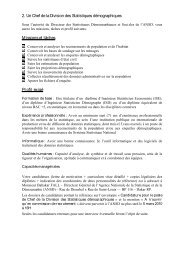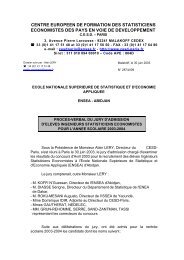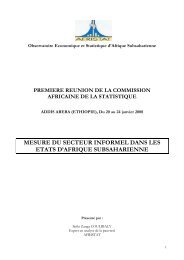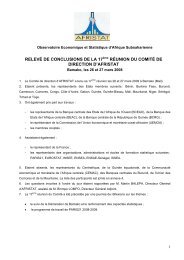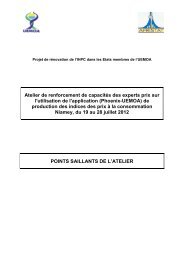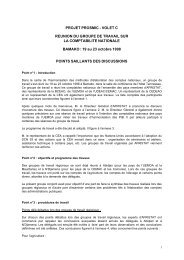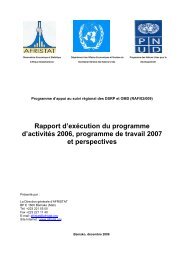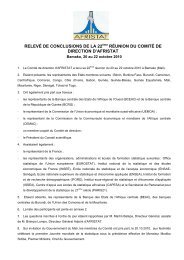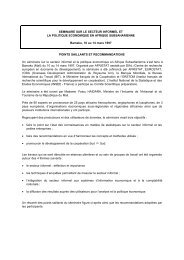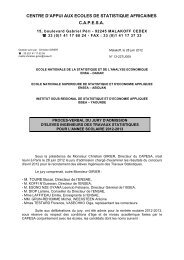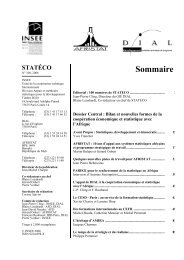Global Purchasing Power Parities and Real Expenditures - Afristat
Global Purchasing Power Parities and Real Expenditures - Afristat
Global Purchasing Power Parities and Real Expenditures - Afristat
You also want an ePaper? Increase the reach of your titles
YUMPU automatically turns print PDFs into web optimized ePapers that Google loves.
Introductionpurchasing power of the U.S. dollar <strong>and</strong> the euro, a Big Maccosts 79 percent more in France than in the United States.Travelers exchanging their dollars to euros would noticethis immediately.PPPs between any pair of countries change slowly,whereas market exchange rates can change quickly. Suddenchanges in PLIs result mainly from changes in marketexchange rates. When market exchange rates change rapidly,a PLI for a country could change too in a short time, indicatingthat a country that was relatively cheap has now becomerelatively expensive compared with the base country.The Use of PPPs <strong>and</strong> Market ExchangeRates for International ComparisonsPPPs are the preferred means of converting the value ofthe GDP <strong>and</strong> its components to a common currency. Theyenable cross-country comparisons of the sizes of economies,average consumption levels, poverty rates, productivity,<strong>and</strong> the use of resources. However, PPPs should not beused for all international comparisons; for example, marketexchange rates should be used to measure internationaltrade, capital flows, or the values of foreign debt.PPPs adjust for differences in price levels betweeneconomies, which may not be reflected in market exchangerates, at least in the short run. Market exchange rates arethe prices at which currencies trade in international markets.Because developing economies tend to have relativelylower wages leading to lower prices for nontraded goods<strong>and</strong> services, a unit of local currency has greater purchasingpower within a developing economy than it does inthe global market. Consequently, the GDP of a developingeconomy <strong>and</strong> the consumption of its residents willtypically be underestimated if market exchange rates areused to compare their value with those of high-incomeeconomies. Although differences in price levels are generallyless pronounced among economies at similar levels ofdevelopment, large <strong>and</strong> rapid movements of exchange ratescan alter the apparent size of economies or the perceivedwelfare of their residents. For example, the Euro exchangerate has changed from US$ 0.853 in October 2000 to US$1.562 in March 2008, but that does not mean that the welfareof Euro area countries has changed accordingly in relationto the United States in that time.There is no need to convert from national currencies toa common currency (whether by market exchange rates orPPPs) when calculating growth rates for a single economy.However, in computing regional (or world) growth rates, thesizes of the economies matter: national GDPs <strong>and</strong> aggregatesare first converted to a common currency <strong>and</strong> then summedto regional (or world) totals, from which growth rates arecomputed. The appropriate conversion factor is providedby PPPs. Developing economies have often had (at leastin the past decade) higher rates of economic growth th<strong>and</strong>eveloped economies. As a result, the global growth ratescomputed with PPP-based activity levels tend to be higherthan those computed using market exchange rates. The reasonis that the developing economies have a higher weightin the PPP-based regional totals (both levels <strong>and</strong> growthrates) than those based on market exchange rates.The initial rounds of the ICP in the 1970s focusedmainly on what are referred to as “volumes” or “real expenditures”of GDP, its major components, <strong>and</strong> their per capitaestimates. PPPs were seen mainly as providing a steppingstonefrom national accounts expressed in national currenciesto volumes expressed in a common currency. In recenttimes, economic analysts have shown increasing interest inPPPs in their own right as a measure of relative price levelsbetween economies.A major use of the PPP results is the estimation of thewidely used “dollar-a-day” international poverty threshold.PPP results also enter the estimation of the United NationsHuman Development Index <strong>and</strong> Gender EmpowermentMeasure, allow the World Health Organization to use healthexpenditures per capita to assess health inequality acrosseconomies, <strong>and</strong> provide the basis for international organizationsto design effective aid programs. The EuropeanCommission relies on PPP-based indicators to allocate theStructural <strong>and</strong> Cohesion Funds across member economies.<strong>Purchasing</strong> power measures are also useful for policymakers at the national level. For example, with the internationallycomparable data, policy makers can draw on theexperience of other economies by comparing the data forthe components of the GDP <strong>and</strong> their relationship to economicgrowth. Similar analyses can inform policy makersof their economy’s comparative advantage by examiningwhich goods or services are relatively cheap or expensivecompared with those of other economies.<strong>Purchasing</strong> power parities allow comparisons betweeneconomies of expenditure shares or price levels for componentssuch as food, health care, <strong>and</strong> investments. Forexample, capital goods tend to be relatively more expensive



